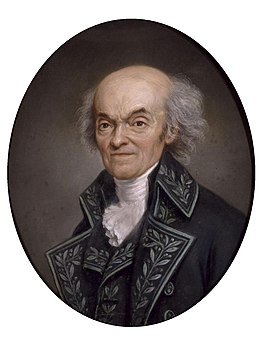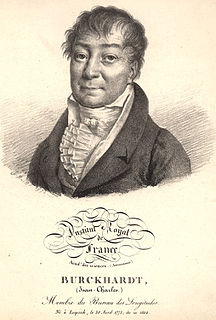
Abbé Nicolas-Louis de Lacaille, formerly sometimes spelled de la Caille, was a French astronomer and geodesist who named 14 out of the 88 constellations. From 1750 to 1754 he studied the sky at the Cape of Good Hope in present-day South Africa. Lacaille observed over 10,000 stars using just a half-inch refractor.
In astronomy and celestial navigation, an ephemeris gives the trajectory of naturally occurring astronomical objects as well as artificial satellites in the sky, i.e., the position over time. The etymology is from Latin ephemeris 'diary' and from Greek ἐφημερίς (ephemeris) 'diary, journal'. Historically, positions were given as printed tables of values, given at regular intervals of date and time. The calculation of these tables was one of the first applications of mechanical computers. Modern ephemerides are often computed electronically, from mathematical models of the motion of astronomical objects and the Earth. However, printed ephemerides are still produced, as they are useful when computational devices are not available.

Joseph Jérôme Lefrançois de Lalande was a French astronomer, freemason and writer.

Astronomical symbols are abstract pictorial symbols used to represent astronomical objects, theoretical constructs and observational events in European astronomy. The earliest forms of these symbols appear in Greek papyrus texts of late antiquity. The Byzantine codices in which many Greek papyrus texts were preserved continued and extended the inventory of astronomical symbols. New symbols were further invented to represent many newly-discovered planets and minor planets discovered in the 18th to the 20th centuries.
The Bureau des Longitudes is a French scientific institution, founded by decree of 25 June 1795 and charged with the improvement of nautical navigation, standardisation of time-keeping, geodesy and astronomical observation. During the 19th century, it was responsible for synchronizing clocks across the world. It was headed during this time by François Arago and Henri Poincaré. The Bureau now functions as an academy and still meets monthly to discuss topics related to astronomy.

Camille Guillaume Bigourdan was a French astronomer.

Jean Picard was a French astronomer and priest born in La Flèche, where he studied at the Jesuit Collège Royal Henry-Le-Grand.

Ferdinand Berthoud, was a scientist and watchmaker. He became master watchmaker in Paris in 1753. Berthoud, who held the position of Horologist-Mechanic by appointment to the King and the Navy, left behind him an exceptionally broad body of work, in particular in the field of sea chronometers.

Nicole-Reine Lepaute, was a French astronomer and mathematician. Lepaute predicted the return of Halley's Comet by calculating the timing of a solar eclipse and constructing a group of catalogs for the stars.

Tobias Mayer was a German astronomer famous for his studies of the Moon.
This is a timeline of the history of piracy.

Franz de Paula Triesnecker was an Austrian Jesuit astronomer.

Johann Karl Burckhardt was a German-born astronomer and mathematician. He later became a naturalized French citizen and became known as Jean Charles Burckhardt. He is remembered in particular for his work in fundamental astronomy, and for his lunar theory, which was in widespread use for the construction of navigational ephemerides of the Moon for much of the first half of the nineteenth century.
The Nautical Almanac has been the familiar name for a series of official British almanacs published under various titles since the first issue of The Nautical Almanac and Astronomical Ephemeris, for 1767: this was the first nautical almanac to contain data dedicated to the convenient determination of longitude at sea. It was originally published from the Royal Greenwich Observatory in England. A detailed account of how the publication was produced in its earliest years has been published by the National Maritime Museum.
Louise du Pierry or Dupiery, née Elisabeth Louise Felicité Pourra de la Madeleine, was a French astronomer and professor.
A fundamental ephemeris of the Solar System is a model of the objects of the system in space, with all of their positions and motions accurately represented. It is intended to be a high-precision primary reference for prediction and observation of those positions and motions, and which provides a basis for further refinement of the model. It is generally not intended to cover the entire life of the Solar System; usually a short-duration time span, perhaps a few centuries, is represented to high accuracy. Some long ephemerides cover several millennia to medium accuracy.
Raphael's Ephemeris is an ephemeris, or set of tables, used in astrology to determine the position of the Sun, Moon and planets. Raphael was a pseudonym used by the original author of the ephemeris, Robert Cross Smith.
Charles-Louis Largeteau (1791–1857) was a French physicist and astronomer. He was born in Mouilleron-en-Pareds in the Vendée into a poor family. His father, a gunner, died in the 1793 Battle of Le Mans. He was taken in by an uncle in Fontenay-le-Comte, and excelled at school there, moving to grammar school in Poitiers. He studied then at the École Polytechnique. In 1813, he joined the Geographical Engineer Corps, where he worked mapping France.










